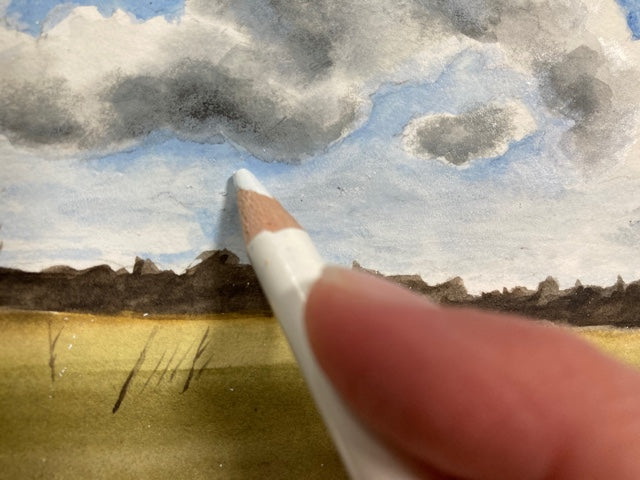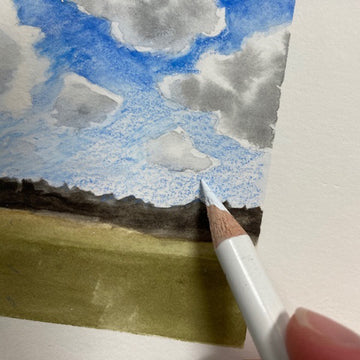Watercolours are infamous for being unforgiving because of their transparent nature. Also, the way water flows add extra unpredictability. So it’s very common to have paintings that don’t turn out the way you hope! Here’s one of mine that disappointed me:

The washes turned out rather uneven in this painting because I didn’t use enough water, and misjudged drying times. If you’re painting in a different location than you’re used to, the humidity might be slightly different and mess with your notions of how long it takes for paint to dry.
I let this painting sit for quite a while because I was disappointed with it, but then it occurred to me that I might be able to rescue it with coloured pencils.

The biggest annoyance I found with this painting was how jagged and un-cloudlike the clouds were. I chose the closest shade of grey from my coloured pencils and began to soften them up.
Now, your success with correcting watercolour blends with coloured pencil is entirely dependent on whether or not you have a coloured pencil that is the right colour. If your shade is slightly different you may have to use your pencils and recolour certain areas to make it blend better.

To cover up a particularly dark edge you didn’t want, you may have to press rather hard on the pencil. You probably won’t be able to eliminate that edge completely, but it will look better than it used to.

Sometimes you’ll find that in order to soften an edge, it works better to blend the background into the object rather than the other way around. It all depends on what pencils you have on hand and how well they are blending into the watercolour hues underneath.
With pencils, it’s better to darken something than to lighten it if you want the blend to be nicer, and sometimes that will mean using the colour of the background to blend an edge.

Since this grey is sort of a middle value between the blue and the lighter grey, it works well to smooth the transition between the two and make the cloud look more real.

Sometimes it can be fun to add in a whole new colour that wasn’t in your watercolour painting. I like this blue a lot so I threw it in random places to make the clouds look more reflective of the sky.

The wash was very uneven below the clouds so I smoothed it out with white.

This blue was great for softening the jagged edges in the darker part of the sky, but less great when I got to the lighter part. It took some blending to make it work in the end.

The white coloured pencil is super useful for blending (don’t use the “colourless blender” pencils; white works so much better for the same thing). I used it to neutralize the choppy look caused by the blue pencil being so much lighter than the watercolour underneath it.

Keep playing with colour fearlessly until you find what you like. I used probably three different browns before finding the one I ultimately liked, but all three shades made the forest look more multidimensional when used together.

Now it’s time to add a little life to the grass. I was not super precise with this but it was still fun and it made the painting look more cared about than before.

As you can see, this final picture may not be the prettiest, but it is certainly much better than it was before the coloured pencils. You will probably have to use a little coloured pencil even in places that didn’t technically need it, just to even out the texture and keep the covered-up mistakes looking like intentional design choices.
There is almost always something that can be done about “mistake” paintings other than abandoning them. It may take time to think it over before you revisit the painting, but chances are you will be able to salvage it as long as you’re open to changing your plans.
Coloured pencils change the texture of a painting and make the effect totally different from before, but that difference can be beautiful, and you just might discover a technique you want to incorporate into your art style!
The most important thing with these salvage projects is to be gentle with yourself and enjoy it, and be thankful for the patience you have in order to revisit something that had frustrated you earlier.



1 comment
Thank you so much for sharing this. I have recently been disappointed by a watercolour painting which I felt could be improved but was not sure what my options were. It was tempting to give it up as a bad job and tear it up!!! But, you have given me hope; so I shall definitely have a go at attempting to turn my failure into something worth saving!